Case Study Analysis: CRC Cycle - COPD Patient, Hadden's Care
VerifiedAdded on 2022/09/26
|7
|1725
|35
Case Study
AI Summary
This case study analyzes a 63-year-old male patient, Hadden, diagnosed with moderate COPD, obstructive sleep apnea, and a history of smoking. The analysis applies the CRC cycle to assess patient priorities, which include medication management and oxygen supply adherence, given the patient's reluctance to comply. The intervention strategies focus on patient education, motivational interviewing, and establishing a therapeutic relationship to encourage self-management skills. Evaluation methods include questionnaires, observation of patient behavior, and monitoring vital signs to assess the effectiveness of the interventions. The assignment emphasizes the significance of communication and self-management in improving patient outcomes, highlighting the importance of the CRC cycle in providing effective patient care and developing nursing knowledge.
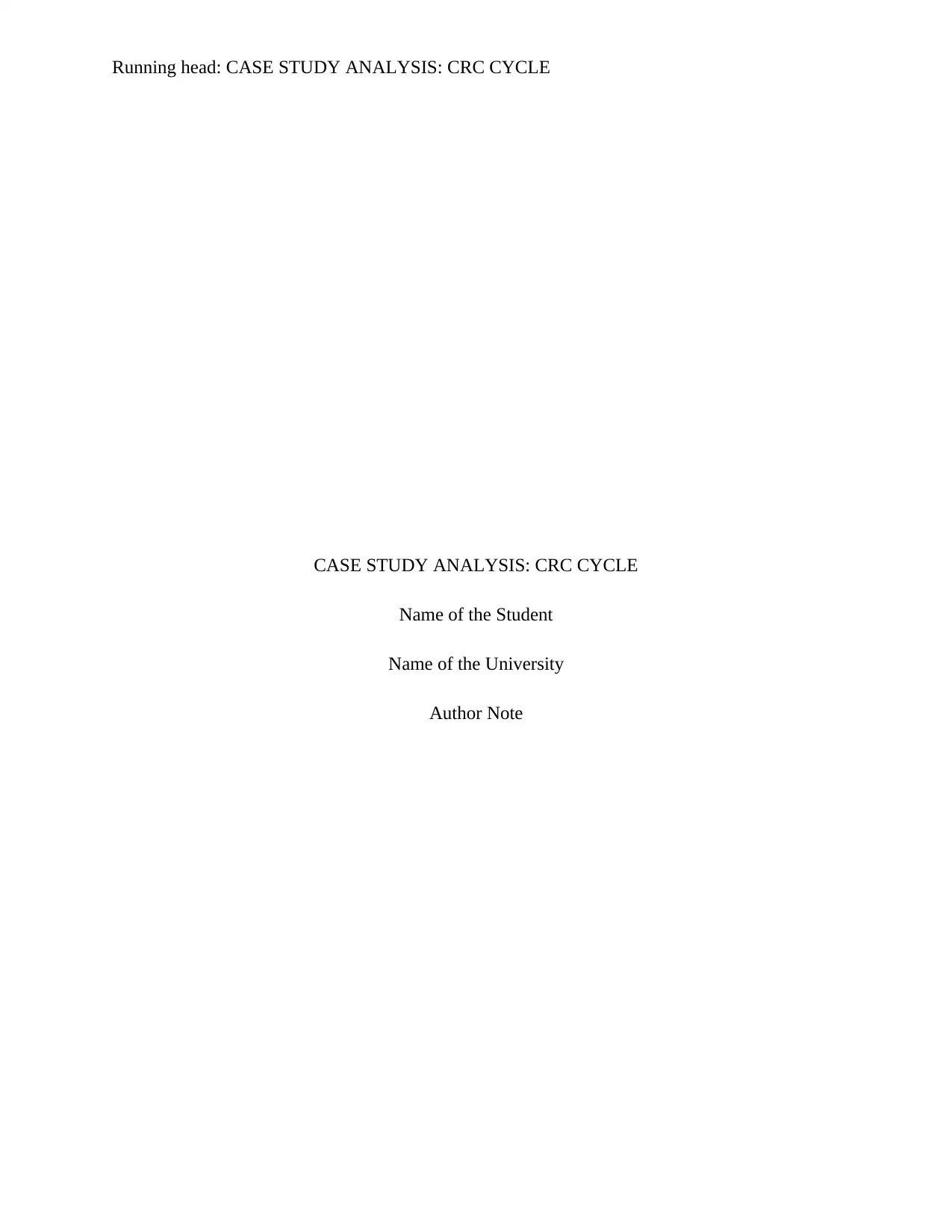
Running head: CASE STUDY ANALYSIS: CRC CYCLE
CASE STUDY ANALYSIS: CRC CYCLE
Name of the Student
Name of the University
Author Note
CASE STUDY ANALYSIS: CRC CYCLE
Name of the Student
Name of the University
Author Note
Paraphrase This Document
Need a fresh take? Get an instant paraphrase of this document with our AI Paraphraser
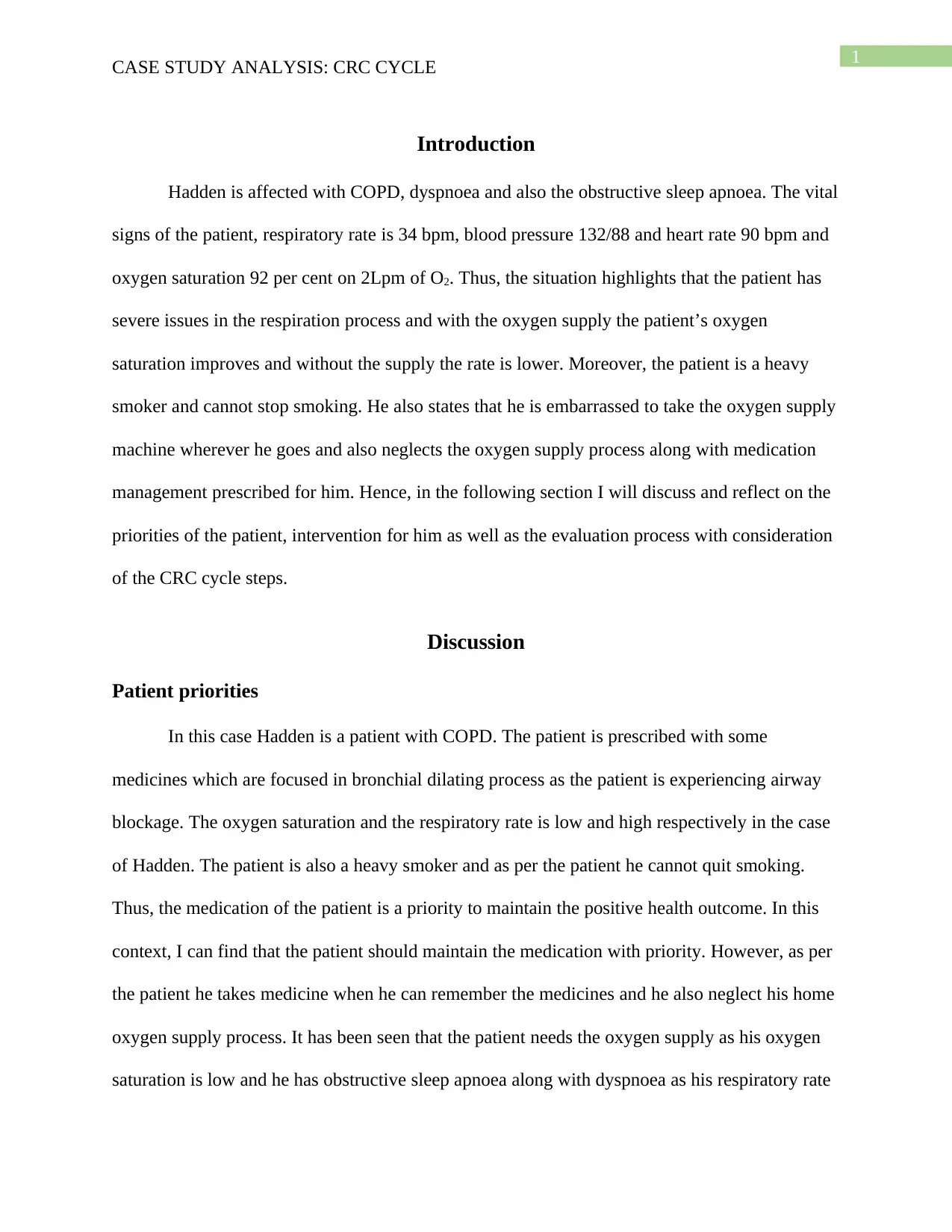
1
CASE STUDY ANALYSIS: CRC CYCLE
Introduction
Hadden is affected with COPD, dyspnoea and also the obstructive sleep apnoea. The vital
signs of the patient, respiratory rate is 34 bpm, blood pressure 132/88 and heart rate 90 bpm and
oxygen saturation 92 per cent on 2Lpm of O2. Thus, the situation highlights that the patient has
severe issues in the respiration process and with the oxygen supply the patient’s oxygen
saturation improves and without the supply the rate is lower. Moreover, the patient is a heavy
smoker and cannot stop smoking. He also states that he is embarrassed to take the oxygen supply
machine wherever he goes and also neglects the oxygen supply process along with medication
management prescribed for him. Hence, in the following section I will discuss and reflect on the
priorities of the patient, intervention for him as well as the evaluation process with consideration
of the CRC cycle steps.
Discussion
Patient priorities
In this case Hadden is a patient with COPD. The patient is prescribed with some
medicines which are focused in bronchial dilating process as the patient is experiencing airway
blockage. The oxygen saturation and the respiratory rate is low and high respectively in the case
of Hadden. The patient is also a heavy smoker and as per the patient he cannot quit smoking.
Thus, the medication of the patient is a priority to maintain the positive health outcome. In this
context, I can find that the patient should maintain the medication with priority. However, as per
the patient he takes medicine when he can remember the medicines and he also neglect his home
oxygen supply process. It has been seen that the patient needs the oxygen supply as his oxygen
saturation is low and he has obstructive sleep apnoea along with dyspnoea as his respiratory rate
CASE STUDY ANALYSIS: CRC CYCLE
Introduction
Hadden is affected with COPD, dyspnoea and also the obstructive sleep apnoea. The vital
signs of the patient, respiratory rate is 34 bpm, blood pressure 132/88 and heart rate 90 bpm and
oxygen saturation 92 per cent on 2Lpm of O2. Thus, the situation highlights that the patient has
severe issues in the respiration process and with the oxygen supply the patient’s oxygen
saturation improves and without the supply the rate is lower. Moreover, the patient is a heavy
smoker and cannot stop smoking. He also states that he is embarrassed to take the oxygen supply
machine wherever he goes and also neglects the oxygen supply process along with medication
management prescribed for him. Hence, in the following section I will discuss and reflect on the
priorities of the patient, intervention for him as well as the evaluation process with consideration
of the CRC cycle steps.
Discussion
Patient priorities
In this case Hadden is a patient with COPD. The patient is prescribed with some
medicines which are focused in bronchial dilating process as the patient is experiencing airway
blockage. The oxygen saturation and the respiratory rate is low and high respectively in the case
of Hadden. The patient is also a heavy smoker and as per the patient he cannot quit smoking.
Thus, the medication of the patient is a priority to maintain the positive health outcome. In this
context, I can find that the patient should maintain the medication with priority. However, as per
the patient he takes medicine when he can remember the medicines and he also neglect his home
oxygen supply process. It has been seen that the patient needs the oxygen supply as his oxygen
saturation is low and he has obstructive sleep apnoea along with dyspnoea as his respiratory rate
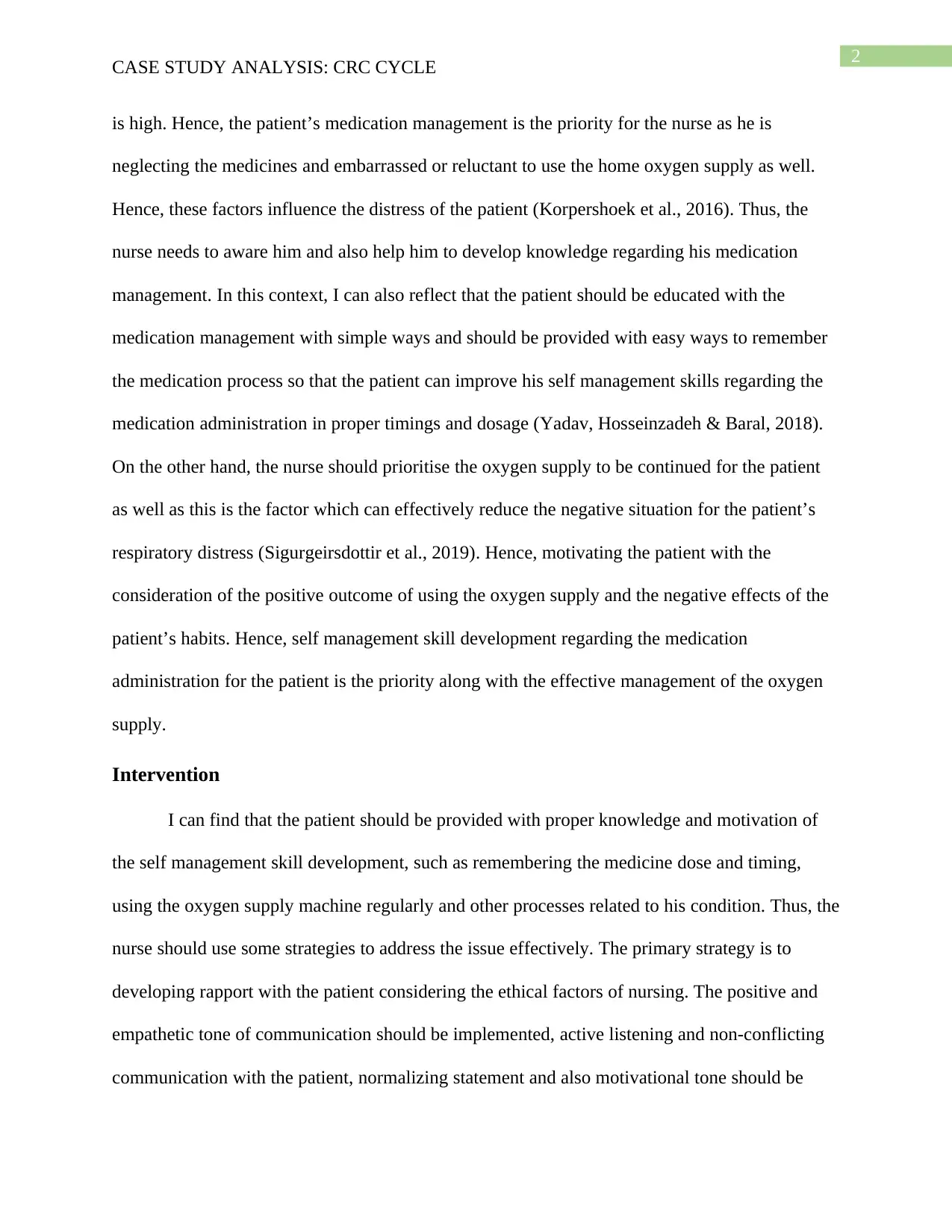
2
CASE STUDY ANALYSIS: CRC CYCLE
is high. Hence, the patient’s medication management is the priority for the nurse as he is
neglecting the medicines and embarrassed or reluctant to use the home oxygen supply as well.
Hence, these factors influence the distress of the patient (Korpershoek et al., 2016). Thus, the
nurse needs to aware him and also help him to develop knowledge regarding his medication
management. In this context, I can also reflect that the patient should be educated with the
medication management with simple ways and should be provided with easy ways to remember
the medication process so that the patient can improve his self management skills regarding the
medication administration in proper timings and dosage (Yadav, Hosseinzadeh & Baral, 2018).
On the other hand, the nurse should prioritise the oxygen supply to be continued for the patient
as well as this is the factor which can effectively reduce the negative situation for the patient’s
respiratory distress (Sigurgeirsdottir et al., 2019). Hence, motivating the patient with the
consideration of the positive outcome of using the oxygen supply and the negative effects of the
patient’s habits. Hence, self management skill development regarding the medication
administration for the patient is the priority along with the effective management of the oxygen
supply.
Intervention
I can find that the patient should be provided with proper knowledge and motivation of
the self management skill development, such as remembering the medicine dose and timing,
using the oxygen supply machine regularly and other processes related to his condition. Thus, the
nurse should use some strategies to address the issue effectively. The primary strategy is to
developing rapport with the patient considering the ethical factors of nursing. The positive and
empathetic tone of communication should be implemented, active listening and non-conflicting
communication with the patient, normalizing statement and also motivational tone should be
CASE STUDY ANALYSIS: CRC CYCLE
is high. Hence, the patient’s medication management is the priority for the nurse as he is
neglecting the medicines and embarrassed or reluctant to use the home oxygen supply as well.
Hence, these factors influence the distress of the patient (Korpershoek et al., 2016). Thus, the
nurse needs to aware him and also help him to develop knowledge regarding his medication
management. In this context, I can also reflect that the patient should be educated with the
medication management with simple ways and should be provided with easy ways to remember
the medication process so that the patient can improve his self management skills regarding the
medication administration in proper timings and dosage (Yadav, Hosseinzadeh & Baral, 2018).
On the other hand, the nurse should prioritise the oxygen supply to be continued for the patient
as well as this is the factor which can effectively reduce the negative situation for the patient’s
respiratory distress (Sigurgeirsdottir et al., 2019). Hence, motivating the patient with the
consideration of the positive outcome of using the oxygen supply and the negative effects of the
patient’s habits. Hence, self management skill development regarding the medication
administration for the patient is the priority along with the effective management of the oxygen
supply.
Intervention
I can find that the patient should be provided with proper knowledge and motivation of
the self management skill development, such as remembering the medicine dose and timing,
using the oxygen supply machine regularly and other processes related to his condition. Thus, the
nurse should use some strategies to address the issue effectively. The primary strategy is to
developing rapport with the patient considering the ethical factors of nursing. The positive and
empathetic tone of communication should be implemented, active listening and non-conflicting
communication with the patient, normalizing statement and also motivational tone should be
⊘ This is a preview!⊘
Do you want full access?
Subscribe today to unlock all pages.

Trusted by 1+ million students worldwide
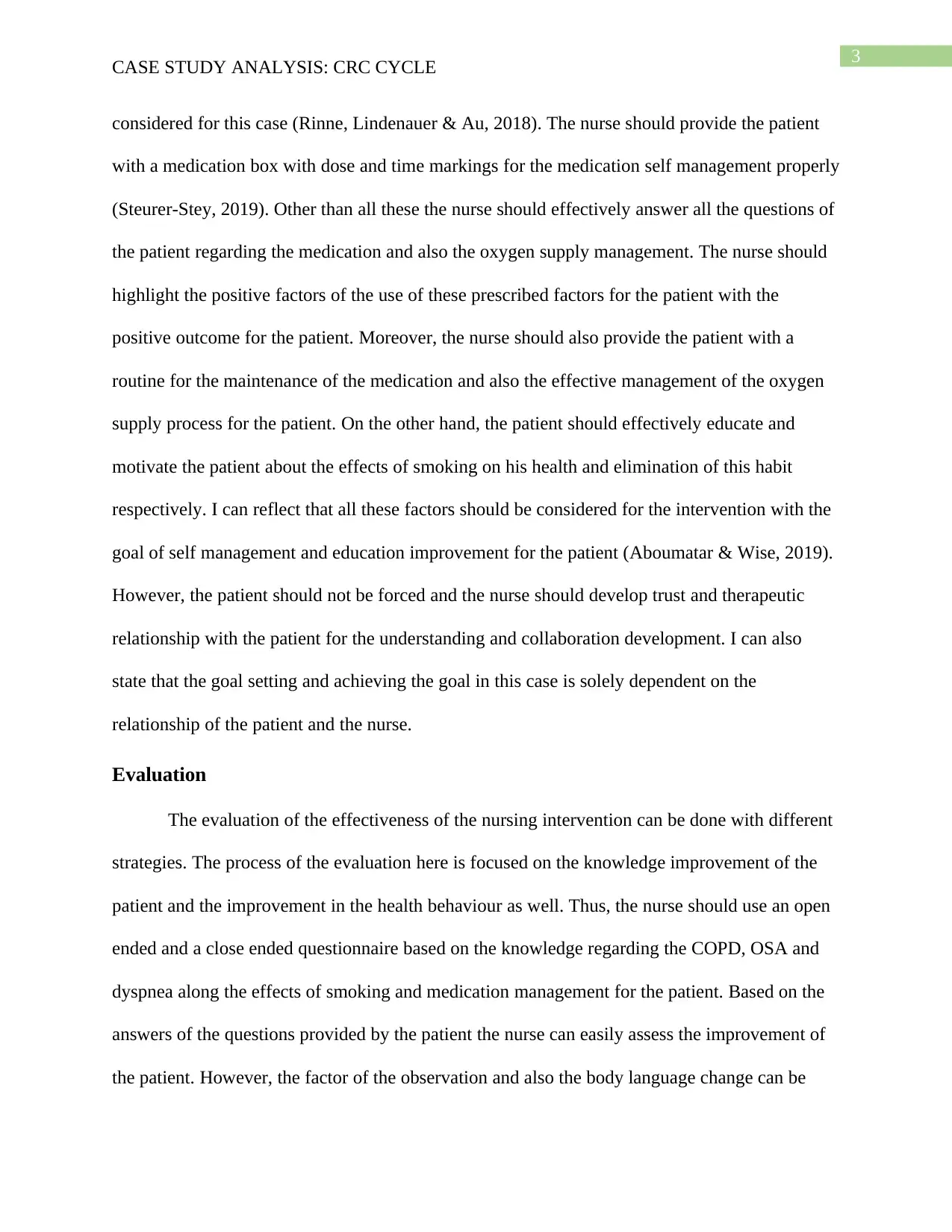
3
CASE STUDY ANALYSIS: CRC CYCLE
considered for this case (Rinne, Lindenauer & Au, 2018). The nurse should provide the patient
with a medication box with dose and time markings for the medication self management properly
(Steurer-Stey, 2019). Other than all these the nurse should effectively answer all the questions of
the patient regarding the medication and also the oxygen supply management. The nurse should
highlight the positive factors of the use of these prescribed factors for the patient with the
positive outcome for the patient. Moreover, the nurse should also provide the patient with a
routine for the maintenance of the medication and also the effective management of the oxygen
supply process for the patient. On the other hand, the patient should effectively educate and
motivate the patient about the effects of smoking on his health and elimination of this habit
respectively. I can reflect that all these factors should be considered for the intervention with the
goal of self management and education improvement for the patient (Aboumatar & Wise, 2019).
However, the patient should not be forced and the nurse should develop trust and therapeutic
relationship with the patient for the understanding and collaboration development. I can also
state that the goal setting and achieving the goal in this case is solely dependent on the
relationship of the patient and the nurse.
Evaluation
The evaluation of the effectiveness of the nursing intervention can be done with different
strategies. The process of the evaluation here is focused on the knowledge improvement of the
patient and the improvement in the health behaviour as well. Thus, the nurse should use an open
ended and a close ended questionnaire based on the knowledge regarding the COPD, OSA and
dyspnea along the effects of smoking and medication management for the patient. Based on the
answers of the questions provided by the patient the nurse can easily assess the improvement of
the patient. However, the factor of the observation and also the body language change can be
CASE STUDY ANALYSIS: CRC CYCLE
considered for this case (Rinne, Lindenauer & Au, 2018). The nurse should provide the patient
with a medication box with dose and time markings for the medication self management properly
(Steurer-Stey, 2019). Other than all these the nurse should effectively answer all the questions of
the patient regarding the medication and also the oxygen supply management. The nurse should
highlight the positive factors of the use of these prescribed factors for the patient with the
positive outcome for the patient. Moreover, the nurse should also provide the patient with a
routine for the maintenance of the medication and also the effective management of the oxygen
supply process for the patient. On the other hand, the patient should effectively educate and
motivate the patient about the effects of smoking on his health and elimination of this habit
respectively. I can reflect that all these factors should be considered for the intervention with the
goal of self management and education improvement for the patient (Aboumatar & Wise, 2019).
However, the patient should not be forced and the nurse should develop trust and therapeutic
relationship with the patient for the understanding and collaboration development. I can also
state that the goal setting and achieving the goal in this case is solely dependent on the
relationship of the patient and the nurse.
Evaluation
The evaluation of the effectiveness of the nursing intervention can be done with different
strategies. The process of the evaluation here is focused on the knowledge improvement of the
patient and the improvement in the health behaviour as well. Thus, the nurse should use an open
ended and a close ended questionnaire based on the knowledge regarding the COPD, OSA and
dyspnea along the effects of smoking and medication management for the patient. Based on the
answers of the questions provided by the patient the nurse can easily assess the improvement of
the patient. However, the factor of the observation and also the body language change can be
Paraphrase This Document
Need a fresh take? Get an instant paraphrase of this document with our AI Paraphraser
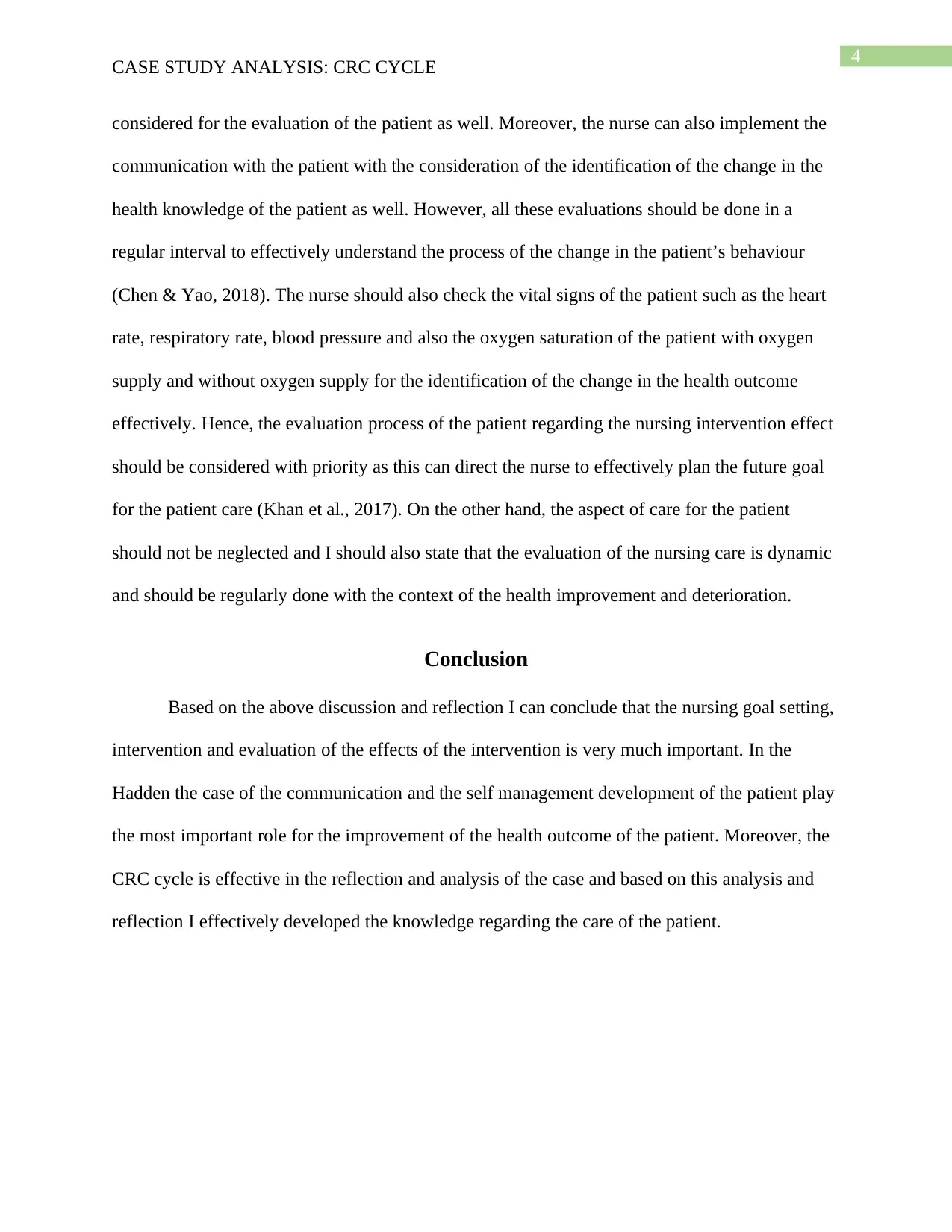
4
CASE STUDY ANALYSIS: CRC CYCLE
considered for the evaluation of the patient as well. Moreover, the nurse can also implement the
communication with the patient with the consideration of the identification of the change in the
health knowledge of the patient as well. However, all these evaluations should be done in a
regular interval to effectively understand the process of the change in the patient’s behaviour
(Chen & Yao, 2018). The nurse should also check the vital signs of the patient such as the heart
rate, respiratory rate, blood pressure and also the oxygen saturation of the patient with oxygen
supply and without oxygen supply for the identification of the change in the health outcome
effectively. Hence, the evaluation process of the patient regarding the nursing intervention effect
should be considered with priority as this can direct the nurse to effectively plan the future goal
for the patient care (Khan et al., 2017). On the other hand, the aspect of care for the patient
should not be neglected and I should also state that the evaluation of the nursing care is dynamic
and should be regularly done with the context of the health improvement and deterioration.
Conclusion
Based on the above discussion and reflection I can conclude that the nursing goal setting,
intervention and evaluation of the effects of the intervention is very much important. In the
Hadden the case of the communication and the self management development of the patient play
the most important role for the improvement of the health outcome of the patient. Moreover, the
CRC cycle is effective in the reflection and analysis of the case and based on this analysis and
reflection I effectively developed the knowledge regarding the care of the patient.
CASE STUDY ANALYSIS: CRC CYCLE
considered for the evaluation of the patient as well. Moreover, the nurse can also implement the
communication with the patient with the consideration of the identification of the change in the
health knowledge of the patient as well. However, all these evaluations should be done in a
regular interval to effectively understand the process of the change in the patient’s behaviour
(Chen & Yao, 2018). The nurse should also check the vital signs of the patient such as the heart
rate, respiratory rate, blood pressure and also the oxygen saturation of the patient with oxygen
supply and without oxygen supply for the identification of the change in the health outcome
effectively. Hence, the evaluation process of the patient regarding the nursing intervention effect
should be considered with priority as this can direct the nurse to effectively plan the future goal
for the patient care (Khan et al., 2017). On the other hand, the aspect of care for the patient
should not be neglected and I should also state that the evaluation of the nursing care is dynamic
and should be regularly done with the context of the health improvement and deterioration.
Conclusion
Based on the above discussion and reflection I can conclude that the nursing goal setting,
intervention and evaluation of the effects of the intervention is very much important. In the
Hadden the case of the communication and the self management development of the patient play
the most important role for the improvement of the health outcome of the patient. Moreover, the
CRC cycle is effective in the reflection and analysis of the case and based on this analysis and
reflection I effectively developed the knowledge regarding the care of the patient.
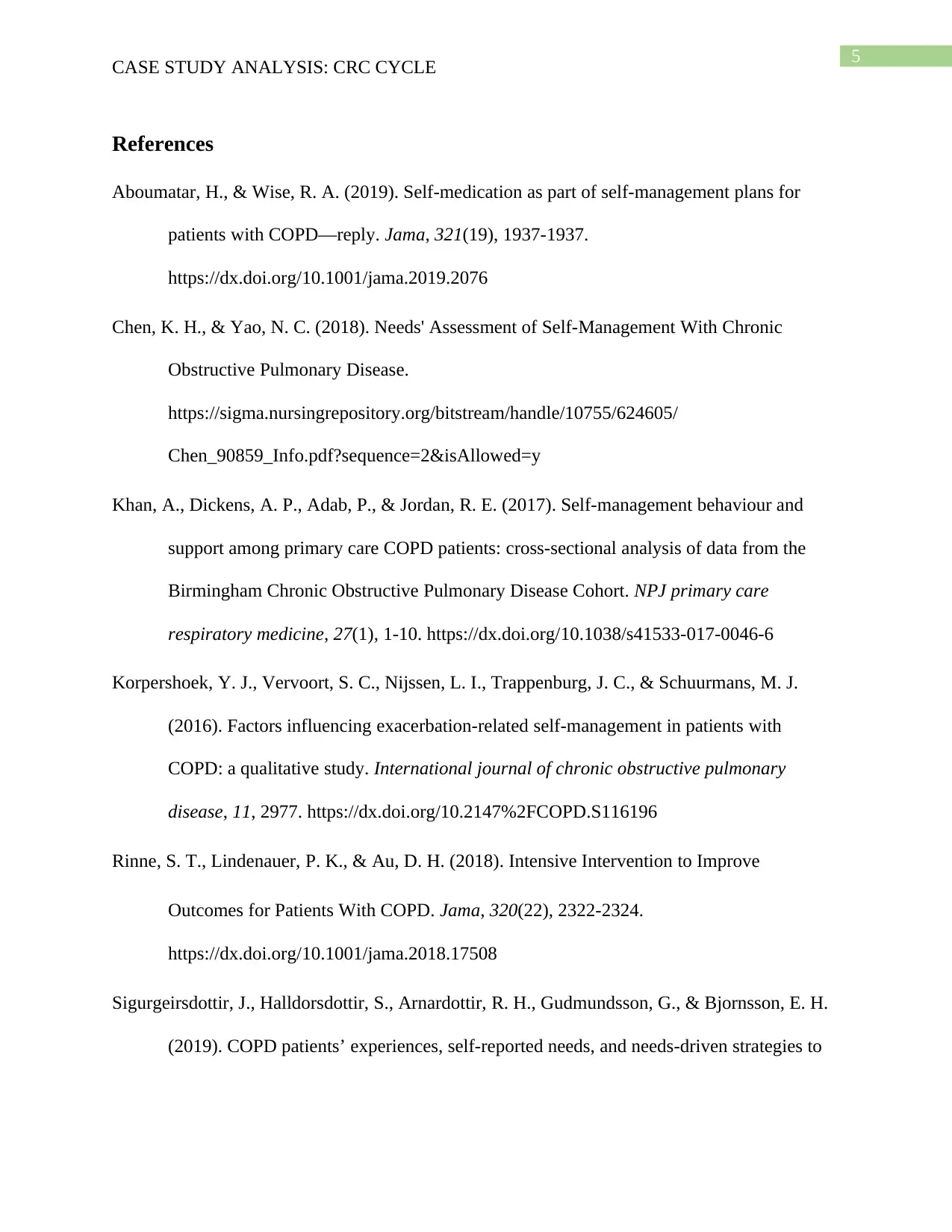
5
CASE STUDY ANALYSIS: CRC CYCLE
References
Aboumatar, H., & Wise, R. A. (2019). Self-medication as part of self-management plans for
patients with COPD—reply. Jama, 321(19), 1937-1937.
https://dx.doi.org/10.1001/jama.2019.2076
Chen, K. H., & Yao, N. C. (2018). Needs' Assessment of Self-Management With Chronic
Obstructive Pulmonary Disease.
https://sigma.nursingrepository.org/bitstream/handle/10755/624605/
Chen_90859_Info.pdf?sequence=2&isAllowed=y
Khan, A., Dickens, A. P., Adab, P., & Jordan, R. E. (2017). Self-management behaviour and
support among primary care COPD patients: cross-sectional analysis of data from the
Birmingham Chronic Obstructive Pulmonary Disease Cohort. NPJ primary care
respiratory medicine, 27(1), 1-10. https://dx.doi.org/10.1038/s41533-017-0046-6
Korpershoek, Y. J., Vervoort, S. C., Nijssen, L. I., Trappenburg, J. C., & Schuurmans, M. J.
(2016). Factors influencing exacerbation-related self-management in patients with
COPD: a qualitative study. International journal of chronic obstructive pulmonary
disease, 11, 2977. https://dx.doi.org/10.2147%2FCOPD.S116196
Rinne, S. T., Lindenauer, P. K., & Au, D. H. (2018). Intensive Intervention to Improve
Outcomes for Patients With COPD. Jama, 320(22), 2322-2324.
https://dx.doi.org/10.1001/jama.2018.17508
Sigurgeirsdottir, J., Halldorsdottir, S., Arnardottir, R. H., Gudmundsson, G., & Bjornsson, E. H.
(2019). COPD patients’ experiences, self-reported needs, and needs-driven strategies to
CASE STUDY ANALYSIS: CRC CYCLE
References
Aboumatar, H., & Wise, R. A. (2019). Self-medication as part of self-management plans for
patients with COPD—reply. Jama, 321(19), 1937-1937.
https://dx.doi.org/10.1001/jama.2019.2076
Chen, K. H., & Yao, N. C. (2018). Needs' Assessment of Self-Management With Chronic
Obstructive Pulmonary Disease.
https://sigma.nursingrepository.org/bitstream/handle/10755/624605/
Chen_90859_Info.pdf?sequence=2&isAllowed=y
Khan, A., Dickens, A. P., Adab, P., & Jordan, R. E. (2017). Self-management behaviour and
support among primary care COPD patients: cross-sectional analysis of data from the
Birmingham Chronic Obstructive Pulmonary Disease Cohort. NPJ primary care
respiratory medicine, 27(1), 1-10. https://dx.doi.org/10.1038/s41533-017-0046-6
Korpershoek, Y. J., Vervoort, S. C., Nijssen, L. I., Trappenburg, J. C., & Schuurmans, M. J.
(2016). Factors influencing exacerbation-related self-management in patients with
COPD: a qualitative study. International journal of chronic obstructive pulmonary
disease, 11, 2977. https://dx.doi.org/10.2147%2FCOPD.S116196
Rinne, S. T., Lindenauer, P. K., & Au, D. H. (2018). Intensive Intervention to Improve
Outcomes for Patients With COPD. Jama, 320(22), 2322-2324.
https://dx.doi.org/10.1001/jama.2018.17508
Sigurgeirsdottir, J., Halldorsdottir, S., Arnardottir, R. H., Gudmundsson, G., & Bjornsson, E. H.
(2019). COPD patients’ experiences, self-reported needs, and needs-driven strategies to
⊘ This is a preview!⊘
Do you want full access?
Subscribe today to unlock all pages.

Trusted by 1+ million students worldwide
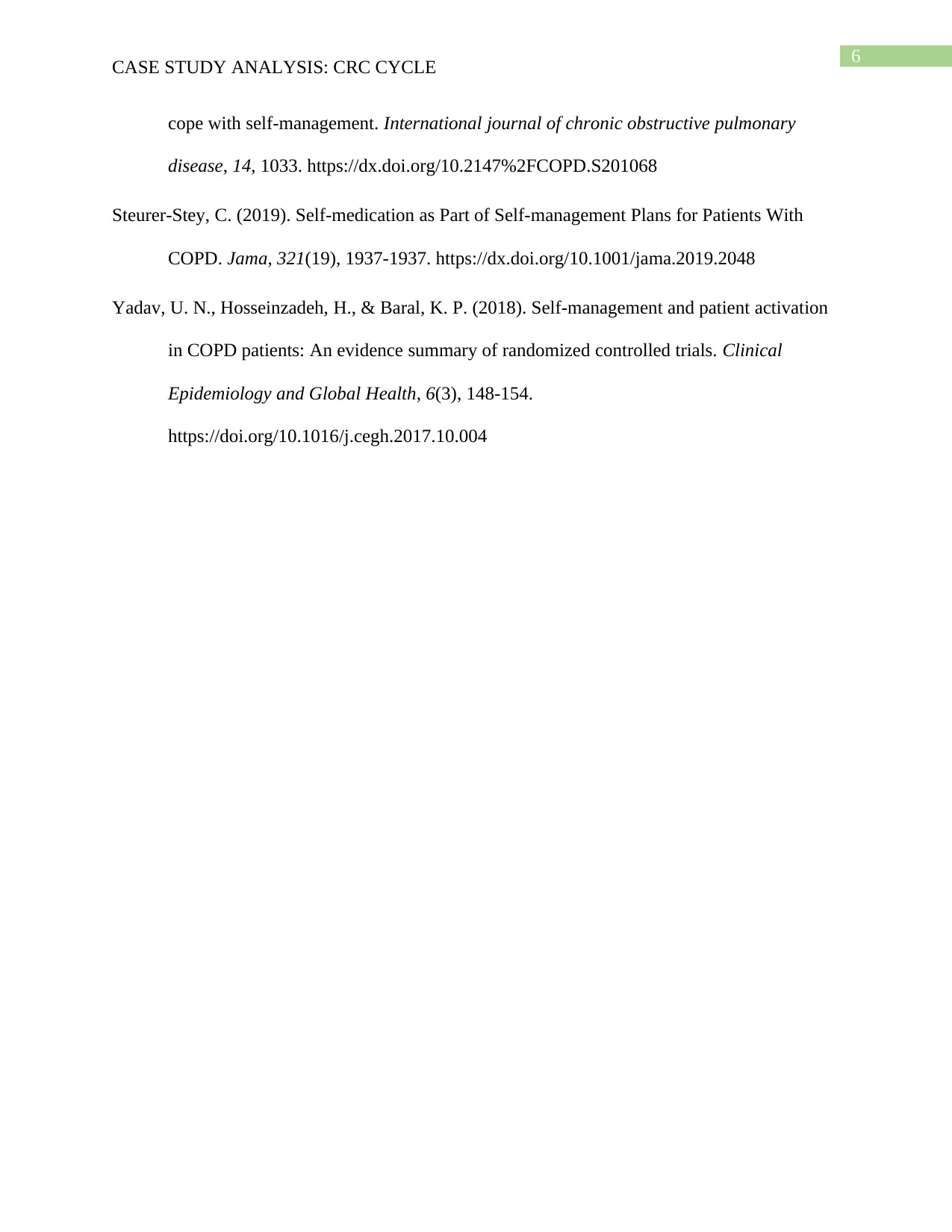
6
CASE STUDY ANALYSIS: CRC CYCLE
cope with self-management. International journal of chronic obstructive pulmonary
disease, 14, 1033. https://dx.doi.org/10.2147%2FCOPD.S201068
Steurer-Stey, C. (2019). Self-medication as Part of Self-management Plans for Patients With
COPD. Jama, 321(19), 1937-1937. https://dx.doi.org/10.1001/jama.2019.2048
Yadav, U. N., Hosseinzadeh, H., & Baral, K. P. (2018). Self-management and patient activation
in COPD patients: An evidence summary of randomized controlled trials. Clinical
Epidemiology and Global Health, 6(3), 148-154.
https://doi.org/10.1016/j.cegh.2017.10.004
CASE STUDY ANALYSIS: CRC CYCLE
cope with self-management. International journal of chronic obstructive pulmonary
disease, 14, 1033. https://dx.doi.org/10.2147%2FCOPD.S201068
Steurer-Stey, C. (2019). Self-medication as Part of Self-management Plans for Patients With
COPD. Jama, 321(19), 1937-1937. https://dx.doi.org/10.1001/jama.2019.2048
Yadav, U. N., Hosseinzadeh, H., & Baral, K. P. (2018). Self-management and patient activation
in COPD patients: An evidence summary of randomized controlled trials. Clinical
Epidemiology and Global Health, 6(3), 148-154.
https://doi.org/10.1016/j.cegh.2017.10.004
1 out of 7
Related Documents
Your All-in-One AI-Powered Toolkit for Academic Success.
+13062052269
info@desklib.com
Available 24*7 on WhatsApp / Email
![[object Object]](/_next/static/media/star-bottom.7253800d.svg)
Unlock your academic potential
Copyright © 2020–2025 A2Z Services. All Rights Reserved. Developed and managed by ZUCOL.





